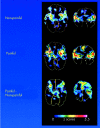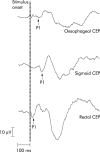Brain imaging and functional gastrointestinal disorders: has it helped our understanding?
- PMID: 15247191
- PMCID: PMC1774137
- DOI: 10.1136/gut.2003.035642
Brain imaging and functional gastrointestinal disorders: has it helped our understanding?
Figures






Similar articles
-
Role of functional brain imaging in gastroenterology in health and disease.Dig Liver Dis. 2000 Mar;32(2):101-3. doi: 10.1016/s1590-8658(00)80393-x. Dig Liver Dis. 2000. PMID: 10975781 Review. No abstract available.
-
Brain research in functional gastrointestinal disorders.J Clin Gastroenterol. 2002 Jul;35(1 Suppl):S23-5. doi: 10.1097/00004836-200207001-00005. J Clin Gastroenterol. 2002. PMID: 12184135 Review.
-
Pain and functional imaging.Philos Trans R Soc Lond B Biol Sci. 1999 Jul 29;354(1387):1347-58. doi: 10.1098/rstb.1999.0483. Philos Trans R Soc Lond B Biol Sci. 1999. PMID: 10466155 Free PMC article. Review.
-
Images of the mind: studies with modern imaging techniques.Annu Rev Psychol. 1994;45:333-56. doi: 10.1146/annurev.ps.45.020194.002001. Annu Rev Psychol. 1994. PMID: 8135505 Review. No abstract available.
-
Functional brain imaging and modeling of brain disorders.Prog Brain Res. 1999;121:185-200. doi: 10.1016/s0079-6123(08)63074-5. Prog Brain Res. 1999. PMID: 10551027 Review. No abstract available.
Cited by
-
The pain system in oesophageal disorders: mechanisms, clinical characteristics, and treatment.Gastroenterol Res Pract. 2011;2011:910420. doi: 10.1155/2011/910420. Epub 2011 Aug 2. Gastroenterol Res Pract. 2011. PMID: 21826137 Free PMC article.
-
Guidelines on the irritable bowel syndrome: mechanisms and practical management.Gut. 2007 Dec;56(12):1770-98. doi: 10.1136/gut.2007.119446. Epub 2007 May 8. Gut. 2007. PMID: 17488783 Free PMC article. Review.
-
A bi-directional assessment of the human brain-anorectal axis.Neurogastroenterol Motil. 2011 Mar;23(3):240-8, e117-8. doi: 10.1111/j.1365-2982.2010.01619.x. Epub 2010 Oct 21. Neurogastroenterol Motil. 2011. PMID: 20964791 Free PMC article.
-
Pimpinella anisum in the treatment of functional dyspepsia: A double-blind, randomized clinical trial.J Res Med Sci. 2015 Jan;20(1):13-21. J Res Med Sci. 2015. PMID: 25767516 Free PMC article.
-
Brain imaging and its implications for studying centrally targeted treatments in irritable bowel syndrome: a primer for gastroenterologists.Gut. 2005 May;54(5):569-73. doi: 10.1136/gut.2004.058446. Gut. 2005. PMID: 15831894 Free PMC article.
References
-
- Derbyshire SW. A systematic review of neuroimaging data during visceral stimulation. Am J Gastroenterol 2003;98:12–20. - PubMed
-
- Hartshorne M . Positron emission tomography. In: Orrison W, Lewine J, Sanders J, et al, eds. Functional brain imaging. St Louis: Mosby, 1995:187–212.
-
- Huang SC, Carson RE, Hoffman EJ, et al. Quantitative measurement of local cerebral blood flow in humans by positron computed tomography and 15O-water. J Cereb Blood Flow Metab 1983;3:141–53. - PubMed
-
- Heeger DJ, Ress D. What does fMRI tell us about neuronal activity? Nat Rev Neurosci 2002;3:142–51. - PubMed
Publication types
MeSH terms
LinkOut - more resources
Full Text Sources
Medical
